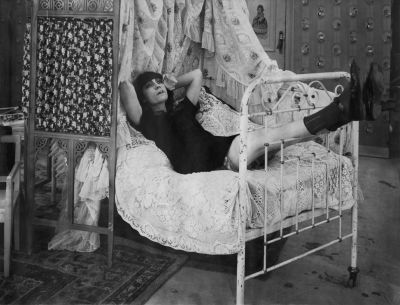
PUBBLICI, GENERI, ATTORI E LA DOTTORESSA ALTENLOH (PARTE 3)
LÉONCE ET SA TANTE (Francia/1913) R.: Léonce Perret. D.: 8'
F.: Georges Specht. Int.: Léonce Perret, Valentine Petit. Prod.: Gaumont. 35mm. L.: 163 m. D.: 8' a 18 f/s. Col. Didascalie inglesi / English intertitles
Da: EYE - Film Institute Netherlands
ENGELEIN (Germania/1913) R.: Urban Gad. D.: 80'
Int.: Asta Nielsen, Max Landa, Alfred Kühne, Fredy Immler, Adele Reuter-Eichberg. Prod.: Projektions-AG Union. 35mm. L.: 1600 m. D.: 80' a 18 f/s. Bn. Didascalie tedesche / German intertitles
Da: Deutsche Kinemathek-Museum für Film und Fernsehen
Accompagnamento al piano di Maud Nelissen
l programma si apre con un western e si chiude con una delle più divertenti commedie tedesche degli ultimi cent'anni, Engelein con Asta Nielsen. I due film vogliono essere un omaggio alla tesi di dottorato di Emilie Altenloh, discussa nel 1913 e pubblicata nel 1914 (ristampa nel 2012), Zur Soziologie des Kinos: Die Kino-Unternehmung und die sozialen Schichten ihrer Besucher. La ricerca della dottoressa Altenloh si basava su interviste, e stabilì che i giovani maschi prediligevano le storie di indiani e i thriller, mentre "le ragazze mostrano scarso entusiasmo per i film con gli indiani o a soggetto storico. Dall'età di quattordici anni, il loro principale interesse è rivolto alle storie d'amore; soprattutto alle storie d'amore che mostrano una maggiore attinenza con le loro vite personali, o che offrono loro un riflesso del mondo che non conoscono. [...] Era dunque inevitabile che Asta Nielsen risultasse così attraente nei film di Urban Gad, e che fosse tanto ammirata". In Engelein Asta Nielsen interpreta una ragazza che recita una parte (diciottenne, finge d'avere dodici anni), in Zapatas Bande e Die Filmprimadonna è un'attrice. La docu-fiction d'ogni tipo domina tra i film del 1913. Nel bio-pic Le Roman de Carpentier (non presente nel programma) il grande boxeur Georges Carpentier appare come interprete della propria vita romanzata. È sempre un momento liberatorio quando gli attori "ci lasciano intravvedere qualcosa di vivo dietro le maschere" (Heide Schlüpmann), o fanno cadere quelle stesse maschere e ammiccando ci dicono che né la finzione né la vita (e nemmeno la morte) dovrebbero essere prese troppo sul serio. Ed è liberatorio vedere una donna indipendente e sicura di sé come Valentine Petit in Léonce et sa tante (nella vita reale Petit era la moglie di Perret), o la giovane Asta/Jesta che in Engelein, con intraprendenza e decisione, prende all'amo il suo uomo.
Mariann Lewinsky
The programme begins with a Western and ends with one of the funniest German comedies of the last hundred years, Asta Nielsen's Engelein. These two films are an hommage to Emilie Altenloh's doctoral dissertation of 1913, published in 1914 (and reprinted in 2012), Zur Soziologie des Kinos: Die Kino-Unternehmung und die sozialen Schichten ihrer Besucher. Altenloh based her study on interviews and ascertained that young males liked tales of Indians and thrillers best, while "the girls show little enthusiasm for films with Indians or historical subject matter. From as young as 14, the main interest for them is love stories, and mainly love stories whose subjects relate most closely to these girls' lives or offer them a reflection of the wider world. [...] Thus it was almost inevitable that Asta Nielsen would have such great appeal in the films of Urban Gad and would be so greatly admired". In Engelein Nielsen plays a teenager who play-acts, in Zapatas Bande and Die Filmprimadonna a film actress. Docu-fiction of all kinds is strikingly prevalent among the 1913 films. Thus, in the biopic Le Roman de Carpentier (not in this programme) the great boxer Georges Carpentier appears in his own fictionalised life story. When the actors "allow us a glimpse of something living behind the masks" (Heide Schlüpmann) or let the masks slip teasingly and tell the audience with a wink that neither fiction nor life (nor death) should be taken too seriously, that is liberating. And it is liberating to see a self-assured, independent woman like Valentine Petit in Léonce et sa tante (in real life Petit was married, to Léonce Perret) or Asta's young Jesta, who is self-confidently and actively reeling in her man.
Mariann Lewinsky


Numero posti: 174
Aria Condizionata
Accesso e servizi per disabili
Il nostro cinema aderisce al circuito CinemAmico: è possibile utilizzare l’applicazione MovieReading® per i film di cui è prevista audiodescrizione e/o sottotitolazione sull'applicazione.
Tel. 051 2195311











